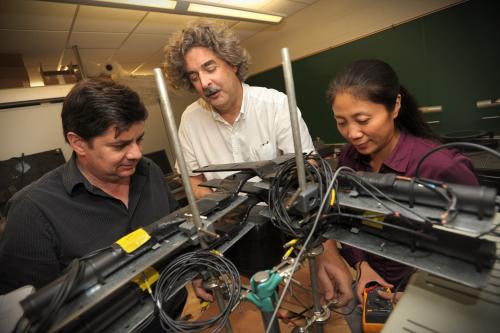A project within the New Mexico State University Department of Physics has been awarded $465,000, bringing its total funding to more than $10,000,000 and allowing the department to remain at the forefront of experimental nuclear and particle physics.

From left, NMSU physics professors Vassili Papavassiliou, Stephen Pate and Xiaorong Wang examine a subatomic particle detector prototype developed in their nuclear physics teaching and research laboratory at Gardiner Hall. (Photo by Darren Phillips)
The project, titled “Experimental Studies of the Quark-Gluon Structure of Nucleons and Nuclei,” was recognized by the university at a Scholarly Excellence Rally held Sept. 4. The event honored NMSU physics professors and project principal investigators Stephen Pate, Vassili Papavassiliou and Xiaorong Wang.
The project and related research have been continually funded by the U. S. Department of Energy since 1985, advancing research efforts for not only NMSU faculty, but their students as well.
“The goal of this project is to explore the internal structure of the protons and neutrons that make up more than 99 percent of the mass of the visible universe,” Wang said. “Our students will perform their research at the scientific frontier and collaborate with top world scientists at national laboratories.”
The team’s research currently takes place at the nation’s only particle collider, the Relativistic Heavy-Ion Collider (RHIC) at Brookhaven National Laboratory in New York, and at the neutrino beam facility at Fermi National Accelerator Laboratory (Fermilab) near Chicago.
At RHIC, the team is working on a collaboration called PHENIX (for Pioneering High-Energy Nuclear-Interaction eXperiment), involving 400-plus scientists from more than a dozen countries. The team is studying the collisions of a variety of combinations of particles to learn about the internal structures of protons and neutrons, and to study the very hot conditions of the early universe.
Pate explained that protons and neutrons, or nucleons, have an internal structure made from particles called quarks and gluons. These particles act as the building blocks of atomic nuclei.
At Fermilab, the group is involved in a new experiment called MicroBooNE. This project, short for “Booster Neutrino Experiment,” is the latest in a series of “BooNE” experiments, with “Micro” referring to its relative size.
This device uses a new detector to study interactions between the nuclei of argon atoms and neutrinos – elementary particles that move at nearly the speed of light, with a mass more than a million times lighter than electrons.
“We will use the neutrinos as probes of the protons and neutrons in the argon nuclei, and also address questions about the nature of the neutrinos themselves,” Pate said.
Over the last decade, this grant has grown to be the largest in the physics department, with these successes enabling joint faculty positions with other research organizations. Such is the case for Wang, who, since 2012, has been in a 5-year joint position with RIKEN-BNL Research Center – located at Brookhaven National Laboratory, but funded seperately through a Japanese research institute called RIKEN. Wang splits her year between on-site research with the PHENIX project, and teaching at NMSU.
For students, this research primarily involves graduates seeking a doctorate in physics. These doctoral candidates typically spend 2-3 years in residence at a national lab, like Brookhaven National Laboratory or Fermilab, where they have the opportunity to collaborate with other researchers and participate in different stages of experiments.
“NMSU students performing research in this field greatly benefit from the diverse cultural and intellectual environment while participating in international scientific collaborations at major labs, and from the opportunity to interact directly with some of the world’s top scientists in their area,” Papavassiliou said.
Through the DOE funding, the project can continue to support 3-4 graduate students per year. Currently, NMSU has three doctoral candidates in residence at Brookhaven, and one at Fermilab, with the project also supporting two post-doctoral appointments, one at each laboratory.
Doctoral candidates Darshana Perera, Jeongsu Bok and Chen Xu are analyzing data from proton-proton collisions at Brookhaven National Laboratory, while Katherine Woodruff is preparing for the first MicroBooNE neutrino-scattering data at Fermilab. Post doctoral researchers include Tia Miceli at Fermilab.
Occasionally, the project will support undergraduates who may work a few hours a week on a project or spend the summer at one of the laboratories.
Most recently, physics undergraduate Alistair McLean spent three summers at Fermilab, writing a 3D visualization tool for understanding the MicroBooNE detector, and Fred Smalley has worked on a design for an additional detector system for MicroBooNE.
In the past, this project has carried out research at facilities not only at Fermilab and Brookhaven, but also at Jefferson Laboratory, Los Alamos National Laboratory, the DESY laboratory in Germany and the Paul Scherrer Institute in Switzerland.
NMSU is a member of the Universities Research Association, a consortium of 86 research universities from around the world. NMSU President Garrey Carruthers recently joined the Board of Trustees of the Universities Research Association, which operates Fermilab in cooperation with the University of Chicago.